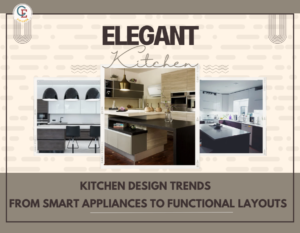The kitchen is more than just a room in the house. It’s where memories are made, laughter fills the air, and the aroma of delicious meals spreads warmth. It’s where Grandma’s secret recipes are passed down, where kids learn to bake their first cookies, and where families gather after a long day to share stories over dinner. The kitchen isn’t just about cooking; it’s about love, togetherness, and the joy of sharing food with the people we care about. It’s a place where simple ingredients come together to create something special, where a warm cup of tea can soothe a troubled heart, and where the simple act of setting the table becomes a gesture of love.
Kitchen Design Trends
The kitchen is often considered the heart of the home, a place where meals are prepared, and families gather. Over the years, Kitchen Design Trends has evolved significantly. Today, it’s not just about aesthetics but also about functionality and efficiency. Let’s explore the latest kitchen design trends that blend smart technology with practical layouts to create beautiful and functional spaces.
Personalization
Personalizing your kitchen means making it match your own style and needs. This can include choosing custom cabinets that fit your taste, picking unique backsplash designs you love, and creating special storage solutions for your cooking habits. Adding personal touches like family photos, artwork, and decor pieces makes the kitchen feel like your own. You can also select colors and lighting that reflect your preferences. Personalizing your kitchen makes it a more enjoyable and functional space just for you.
Here are some simple ways to personalize your kitchen:
Custom Cabinets: Choose cabinets that fit your space and style, whether modern or traditional.
Unique Backsplashes: Pick a backsplash design that you love, like colorful tiles or elegant patterns.
Special Storage: Create storage solutions tailored to how you cook, such as special racks for your favorite utensils.
Decorative Touches: Add personal items like family photos, artwork, or special decor pieces.
Color Choices: Use your favorite colors for walls, cabinets, and accessories.
Lighting: Select lighting that matches your style and provides the right mood and brightness.
Personalization makes your kitchen feel uniquely yours and suits your lifestyle perfectly.
Smart Appliances
Smart appliances in the kitchen are modern devices that use advanced technology to improve how we cook and clean. They can connect to the internet and be controlled by smartphones or voice commands. These appliances help make kitchen tasks quicker, easier, and more convenient by using technology to streamline everyday activities.
The benefits of smart appliances in the kitchen are numerous. They save time by allowing you to control and monitor your devices remotely. They make cooking easier with features like automatic settings and reminders. They help reduce energy and water use, making them more eco-friendly. Overall, smart appliances make kitchen tasks more convenient and efficient, making your daily routine smoother and more enjoyable.
These high-tech devices can make cooking easier, faster, and more enjoyable. Here are a few examples:
Smart Refrigerators: These come with touch screens and Wi-Fi connectivity, allowing you to see what’s inside without opening the door. Some even suggest recipes based on the ingredients you have.
Smart Ovens: These can be controlled via smartphone apps, so you can preheat your oven on your way home from work. They also come with features like voice control and automatic cooking settings.
Smart Dishwashers: These can be programmed to start at specific times, and some models can even diagnose problems and suggest solutions through an app.
Smart Coffee Makers: Imagine waking up to freshly brewed coffee that you started brewing from your bed using your phone.
Functional Layouts
Functional layouts in the kitchen are designs that make cooking and cleaning easier by organizing the space efficiently. They focus on placing key areas, like the sink, stove, and refrigerator, in a way that reduces the need to move around too much. This can save time and effort when preparing meals. Common layouts include open floor plans, which connect the kitchen to other living spaces; island kitchens, which add extra workspace in the center; and galley kitchens, which have two parallel countertops for a compact and efficient setup. These layouts aim to make the kitchen more practical and comfortable to use.
Different layouts arrange the sink, stove, refrigerator, and countertops in various configurations to suit different needs and spaces:
Work Triangle: This design places the sink, stove, and refrigerator at three points of a triangle, making it easy to move between them.
Open Floor Plans: These layouts connect the kitchen to other living areas, creating a spacious and social environment.
Island Kitchens: These have a central counter (island) for extra workspace and seating.
Galley Kitchens: These have two parallel countertops for a compact and efficient workspace.
L-Shaped and U-Shaped Layouts: These layouts provide lots of counter space and storage, ideal for larger kitchens.
Design principles focus on making the kitchen functional and pleasant. They include:
Efficiency: Arranging the kitchen so that you can easily move between key areas.
Storage: Ensuring there is enough space for all kitchen items.
Accessibility: Making sure everything is within easy reach.
Lighting: Having good lighting to see clearly while cooking.
Safety: Designing the kitchen to prevent accidents, like keeping flammable items away from the stove.
Storage Solutions
Effective storage is key to a functional kitchen. Here are some trends in kitchen storage:
Pull-Out Cabinets: These make it easy to access pots, pans, and other kitchen essentials without having to dig through cluttered shelves.
Open Shelving: This trend not only makes it easy to find what you need but also allows you to display your beautiful dishes and cookware.
Pantry Cabinets: Tall cabinets with pull-out shelves or drawers provide ample storage for groceries and kitchen supplies.
Drawer Organizers: Keep your utensils, spices, and other small items neatly organized and easily accessible.
Aesthetic Trends
While functionality is crucial, aesthetics also play a significant role in kitchen design. Here are some current aesthetic trends:
Minimalism: Clean lines, neutral colors, and clutter-free spaces create a calm and inviting atmosphere.
Bold Colors: On the other hand, some homeowners are opting for bold colors like navy blue, emerald green, and deep red to make a statement.
Natural Elements: Incorporating wood, stone, and plants brings a touch of nature into the kitchen, creating a warm and earthy feel.
Mixed Metals: Combining different metal finishes, like brass and stainless steel, adds visual interest and sophistication.
Statement Backsplashes: A striking backsplash can serve as the focal point of the kitchen, adding personality and style.
Multi-Functional Spaces
Modern kitchens are often multi-functional spaces that serve various purposes beyond cooking. Here’s how to design a kitchen that meets all your needs:
Breakfast Nooks: A cozy nook with a small table and seating is perfect for casual meals and morning coffee.
Workstations: With more people working from home, incorporating a small desk or workspace into the kitchen can be very practical.
Entertainment Areas: An open kitchen with a bar or island seating makes it easy to entertain guests while preparing food.
Kids’ Zones: Creating a designated area for kids, with lower countertops and storage, can make the kitchen a family-friendly space.
Technology Integration
Beyond smart appliances, technology is becoming deeply integrated into kitchen design. Here are some tech-savvy features:
Voice-Controlled Assistants: Devices like Amazon Echo or Google Home can control kitchen appliances, play music, set timers, and provide cooking tips.
Touchless Faucets: These faucets can be turned on and off with a wave of your hand, making them both convenient and hygienic.
Smart Lighting: Adjustable lighting that can be controlled via smartphone or voice command allows you to set the perfect ambiance for any occasion.
Charging Stations: Integrated USB ports and charging stations ensure that your devices are always powered up and within reach.
Sustainable Design
Sustainable kitchen design focuses on making choices that are good for the environment. This includes using energy-efficient appliances that use less electricity and water-saving fixtures like faucets and dishwashers. It also involves choosing materials that are eco-friendly, such as bamboo or recycled wood for cabinets and countertops. Additionally, sustainable design encourages recycling and composting to reduce waste. Overall, it aims to create a kitchen that is both beautiful and kind to the planet. Here are the key points of sustainable kitchen design in very simple words:
Energy-Efficient Appliances: Use appliances that use less electricity.
Water-Saving Fixtures: Install faucets and dishwashers that use less water.
Eco-Friendly Materials: Choose materials like bamboo or recycled wood.
Recycling: Set up a recycling station for paper, plastic, and glass.
Composting: Compost food scraps to reduce waste.
Low-VOC Paints: Use paints that have fewer harmful chemicals.
LED Lighting: Use LED lights because they use less energy and last longer.
Natural Light: Maximize natural light to reduce the need for artificial lighting.
The latest kitchen design trends combine smart technology with functional layouts to create spaces that are both beautiful and practical. Whether you’re planning a complete kitchen remodel or just looking to update your space, consider incorporating some of these trends to create a kitchen that meets your needs and reflects your personal style. With the right blend of smart appliances, efficient layouts, and personalized touches, your kitchen can become the heart of your home where memories are made and cherished for years to come.
For a deeper dive into construction insights and industry updates, we invite you to explore our extensive collection of construction blogs. Gain valuable knowledge and stay updated by navigating through the following blog links. Happy exploring
What is Modular and Prefabrication Technique ?
Mumbai Trans Harbour Link : Atal Setu 2024
Feel free to follow us there on Instagram and drop a comment to say hello!



